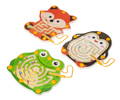Montessori Toys for Toddlers: A Comprehensive Buying Guide
Every parent has been there: standing in an aisle, surrounded by a dizzying display of toys, wondering which ones are actually worth it. The shiniest ones? The wooden ones? The ones with the most famous brand name?

With the Montessori approach gaining traction, many parents are now looking for toys that not only entertain but also educate. But what exactly are Montessori toys, and why are they special?
Montessori, a method developed by Dr. Maria Montessori over a century ago, emphasizes hands-on, self-paced learning. And it's not just about school; it's a philosophy that can be incorporated into daily life, including play.
So, if you're keen on introducing your toddler to toys that align with this approach, you're in the right place. In this guide, we'll help you navigate the realm of Montessori toys for toddlers, ensuring that your little one's playtime is both fun and fruitful.
Defining Montessori Toys for Toddlers: What Sets Them Apart?

When you think about toys, you might picture colorful plastic items with lights and sounds that often require batteries. Montessori toys, however, take a different approach.
- Simple in design: Montessori toys are typically straightforward, without too many distractions. This simplicity encourages children to use their imagination and creativity rather than being led by the toy itself.
- Encourages real-life skills: A lot of Montessori toys mirror real-life activities, like dressing frames for practicing buttons and zips or wooden cutlery sets. This way, as kids play, they're also building skills they'll use daily.
- Self-correcting: Many Montessori materials are designed so that kids can figure out mistakes and correct them on their own. This not only builds problem-solving skills but also fosters independence and confidence.
- Grows with the child: Instead of toys that entertain for a short while and then get discarded, Montessori toys often have multiple uses and can adapt as your child grows and learns.
TIP: The next time you're evaluating a toy, consider these factors. Is it overly complex or distracting? What's it made of? Does it reflect real-world tasks, and can your child explore and learn with it independently? These questions can help guide your choices.
Benefits of Montessori Toys for Toddlers
While any toy can bring a smile to a toddler's face, Montessori toys go a step further by offering more than just entertainment. Let's explore:
Cognitive Benefits
These toys are designed to challenge the mind, laying a foundation for critical thinking. They teach cause and effect, problem-solving, and sequencing, making kids more adept at understanding complex ideas as they grow.
- Example: A simple stacking tower helps toddlers understand sizes and spatial relationships.

Motor Skill Development
Many Montessori toys require hands-on interaction. As kids grab, stack, lace, or pour, they hone fine motor skills. These activities also improve hand-eye coordination, which plays a vital role in everyday tasks.
- Example: Lacing toys not only improve dexterity but also prepare children for skills like tying shoelaces.

Imagination and Creativity
While Montessori emphasizes real-world learning, it doesn't neglect the imaginative side. Toys that allow for open-ended play mean each play session can be a new adventure, fostering creativity.
- Example: A set of wooden blocks can become a tower, a bridge, or a castle, depending on the child's imagination.

Real-world Learning
One standout feature of Montessori toys is their emphasis on the world around us. This is because most children prefer real-life activities rather than fantasy. As kids play, they subconsciously prepare for tasks and challenges they'll face as they grow.
- Example: A toy kitchen set doesn't just entertain; it introduces kids to concepts of organization, sequencing (first we cook, then we eat), and even basic math (two cups of water, three spoons of flour).

In essence, Montessori toys aren't just playthings; they're tools. They bridge the gap between fun and learning, ensuring that those early, formative years are as enriching as possible.
Choosing the Right Montessori Toy for Your Toddler
With countless toys on the market, zeroing in on the best Montessori toys for your toddler might feel like finding a needle in a haystack. But with the right insights, you can make choices that not only entertain your child but also aid their development.
Here's a roadmap to help you navigate:
1. Age Appropriateness: Not every toy is suitable for every age. Look for toys that match your toddler's developmental stage. For instance, large bead stringing activities are great for younger toddlers, while more complex puzzles might be suitable as they approach three.
2. Material Considerations: Montessori emphasizes natural materials like wood, metal, and fabric. These materials are not only durable but also provide a rich sensory experience. So, if you're stuck between a plastic toy and a wooden one, it might be worth leaning toward the latter.
3. Versatility: The best toys can be used in multiple ways. Blocks, for example, can be stacked, sorted by size or color, used in pretend play, or even counted. Toys that grow with your child and offer various ways to play give you more bang for your buck.
4. Longevity and Adaptability: It's tempting to buy the latest toy that everyone's raving about, but will your child still be interested in it six months down the line? Opt for toys that can adapt as your child's skills and interests expand.
5. User Feedback and Reviews: Listening to other parents can be a goldmine of insights. Before purchasing, it might be worth scanning reviews or even asking within your social circle. Real-life experiences from other parents can give you a clear picture of the toy's practicality, durability, and educational value.
6. Safety: No matter how educational or engaging a toy might be, safety always comes first. When evaluating Montessori toys, keep in mind if parts are too small, if edges and corners are too sharp, and regularly inspect for wear and tear.
Remember, the goal isn't to fill a toy box; it's to choose toys that foster growth, independence, and genuine enjoyment. Sometimes, less really is more.
Our top picks!
These are some of our suggestions for your first Montessori toys for toddlers. If you’re interested in more, you can always check them in our section of best Montessori toys for 2-year-olds.
Building Blocks

Magnetic Maze

Conclusion:
Selecting the right toys for your toddler isn't just about keeping them occupied—it's about investing in their growth and development. Montessori toys stand out because they are thoughtfully designed to do just that.
As parents, we want to provide the best for our children, and ensuring their playtime is both enjoyable and educational is a step in the right direction.
Whether you're new to the Montessori approach or a seasoned pro, always remember that the best toy choices are those that match your child's curiosity and developmental needs. As they play, learn, and evolve, you'll know you made the right call.
P.S. If you’ve fallen in love with Montessori education like we did, you can even try implementing Montessori at home. Write to us at info@montessorigeneration.com and let us know how it worked out.
Free Delivery
Over $80
Easy Returns
No questions asked
Unbeatable Warranty
1-year ++ warranty
- Secure CheckoutWorld’s most secure payment method





